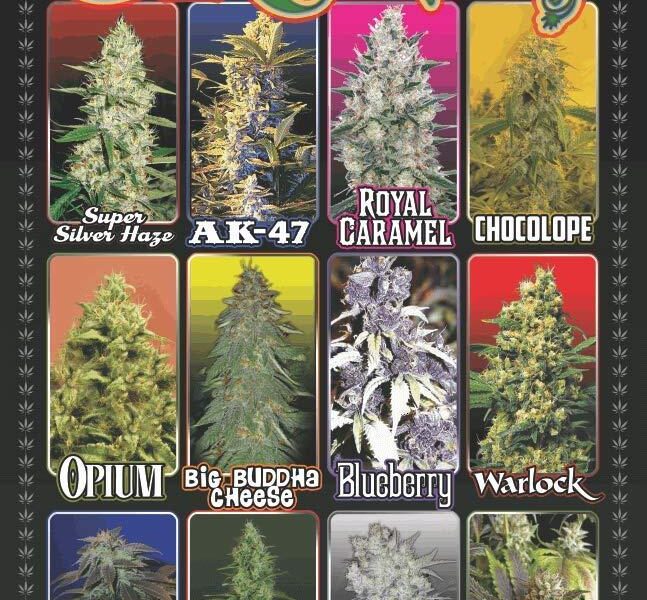As society evolves and our understanding of cannabis deepens, the conversation around different forms of marijuana has never been more pertinent. What was once shrouded in stigma is now celebrated for its diverse uses and myriad forms. From the aromatic buds that grace dispensaries to the trend of oils, edibles, and concentrates, marijuana takes on a multitude of identities that cater to varying preferences and needs. This article embarks on a journey through the expansive world of cannabis, exploring its various forms, their unique characteristics, and the ways they cater to both therapeutic and recreational users. Whether you’re a seasoned enthusiast or a curious newcomer, understanding these distinctions is key to navigating the rich landscape of marijuana today. Join us as we unravel the complexities and curiosities of this multifaceted plant, shedding light on what makes each form special in its own right.
Table of Contents
- Exploring the Varieties of Marijuana: Understanding Strains and Effects
- The Rise of Concentrates: A Deep Dive into Oils, Wax, and Shatter
- Edibles Uncovered: Delicious Alternatives and Their Unique Experiences
- Medical Marijuana: Tailoring Treatments with Specific Forms for Relief
- Q&A
- In Summary
Exploring the Varieties of Marijuana: Understanding Strains and Effects
When delving into the world of marijuana, one quickly learns that not all strains are created equal. The primary categories are typically Indica, Sativa, and Hybrid, each offering distinct characteristics and effects. Indica strains are known for their relaxing properties, making them ideal for unwinding after a long day. On the other hand, Sativa strains invigorate the mind, often leading to enhanced creativity and social interactions. Hybrids combine elements of both, offering a balance that can cater to various needs and preferences.
To better understand these categories, consider their effects, flavors, and uses:
| Strain Type | Common Effects | Typical Flavors | Best Use |
|---|---|---|---|
| Indica | Relaxation, Sleepiness | Earthy, Sweet | Evening, Relaxation |
| Sativa | Euphoria, Energy | Citrus, Spicy | Daytime, Creativity |
| Hybrid | Balanced Effects | Varied | Anytime Use |
Exploring these variations allows enthusiasts and casual users alike to discover a strain that aligns with their desired experience, whether it’s soothing anxiety, sparking creativity, or enhancing social gatherings. Understanding the intricacies of each type broadens the appreciation for this diverse plant and its capabilities.
The Rise of Concentrates: A Deep Dive into Oils, Wax, and Shatter
The evolution of concentrates has transformed the consumption of cannabis, bringing forth a variety of potent products that cater to the diverse preferences of users. Among these, oils, waxes, and shatter stand out for their distinct characteristics, textures, and methods of extraction. Oils, often infused with terpenes for flavor and aroma, are versatile and can be used in vapor pens, edibles, or applied sublingually. Waxes, known for their sticky consistency, typically offer high potency and can be dabbed or vaporized for an immediate effect. On the other hand, shatter, a brittle glass-like form, is prized for its purity and high tetrahydrocannabinol (THC) content, making it a favorite among seasoned cannabis enthusiasts.
Each of these concentrates presents unique benefits and challenges that appeal to different segments of the cannabis community. Users often select based on desired effects, method of consumption, and flavor profile. Here’s a quick comparison of these forms:
| Type | Texture | Potency | Best For |
|---|---|---|---|
| Oils | Liquid | Moderate to High | Vaping, Edibles |
| Waxes | Sticky, Viscous | High | Dabbing, Vaping |
| Shatter | Glass-like | Very High | Dabbing |
Edibles Uncovered: Delicious Alternatives and Their Unique Experiences
Marijuana has evolved significantly beyond traditional methods of consumption, unlocking a world of edibles that tantalize the taste buds and elevate the experience. From gummies and chocolates to beverages and baked goods, there’s something for every palate. These tasty alternatives not only provide a discreet option for users but also deliver a unique and often prolonged effects profile compared to smoking or vaping. The beauty of edibles lies in their ability to integrate seamlessly into daily life, whether enjoyed as a late-night snack or consumed during a social gathering, transforming any moment into an extraordinary experience.
When exploring the various forms of marijuana-infused treats, it’s essential to understand how each type can affect the body differently. Cannabinoids are metabolized in a unique way through edibles, leading to a more robust and long-lasting high. Here’s a quick comparison of popular edible options and their typical onset and duration of effects:
| Edible Type | Onset Time | Duration of Effects |
|---|---|---|
| Gummies | 30-60 minutes | 4-6 hours |
| Chocolates | 20-45 minutes | 4-8 hours |
| Beverages | 30-90 minutes | 2-6 hours |
| Baked Goods | 30-60 minutes | 3-7 hours |
With the rise of these culinary curiosities, it’s no wonder that more enthusiasts are opting for edibles as their preferred mode of consumption. Not only are they a source of delight and experimentation, but they also encourage creativity in cooking and baking, as users can explore homemade versions for a personalized experience. The world of edibles is rich and varied, opening up endless possibilities to enhance personal routines while savoring every bite along the way.
Medical Marijuana: Tailoring Treatments with Specific Forms for Relief
Understanding the various forms of medical marijuana is essential for tailoring treatment to individual needs. Each form offers unique benefits and can be utilized based on the patient’s lifestyle, condition, and preferences. Some popular forms include:
- Vaporization: Inhaled vapor provides rapid relief and is often preferred for quick-acting effects.
- Edibles: Infused food products offer more extended relief, making them ideal for chronic conditions.
- Tinctures: Liquid extracts allow for precise dosing and can be absorbed sublingually for quick effects.
- Topicals: Creams and balms provide localized pain relief without psychoactive effects.
When considering which form to use, it’s crucial to match the delivery method with the desired outcome. For instance, individuals seeking immediate pain relief might find vaporization or tinctures more effective, while those needing longer-lasting effects might opt for edibles. Below is a simple comparison table highlighting the key attributes of each form:
| Form | Onset Time | Duration |
|---|---|---|
| Vaporization | Immediate (minutes) | 2-4 hours |
| Edibles | 30-90 minutes | 4-8 hours |
| Tinctures | 15-45 minutes | 4-6 hours |
| Topicals | Variable (local) | 2-6 hours |
Q&A
Q&A: Exploring the Different Forms of Marijuana
Q1: What are the primary forms of marijuana that people commonly use?
A1: Marijuana comes in several forms, each with unique characteristics and methods of consumption. The most common include:
- Dried Flower: This is the classic form, consisting of the cannabis plant’s buds. Users can smoke it in joints, pipes, or bongs.
- Edibles: These are food products infused with cannabinoids, often in the form of gummies, chocolates, or baked goods. They provide a discreet and alternative method of consumption.
- Concentrates: These include oils, waxes, and shatter, which contain higher concentrations of THC and can be consumed through dabbing or added to joints.
- Tinctures: Marijuana-infused alcohol or oil extracts that offer a quick way to absorb cannabinoids when taken sublingually (under the tongue).
- Topicals: Creams, balms, and lotions infused with cannabis, ideal for localized pain relief without the psychoactive effects.
Q2: How do the effects differ between smoking marijuana and consuming edibles?
A2: The effects can vary significantly between the two methods. Smoking marijuana typically leads to a quicker onset of effects, usually within minutes, and allows for more immediate control over dosage. In contrast, edibles may take 30 minutes to 2 hours to kick in, leading some users to underestimate their potency and consume more than intended. The experience with edibles also tends to be longer-lasting and can produce a different type of high due to the way the body metabolizes THC through digestion.
Q3: What are concentrates, and why are they becoming increasingly popular?
A3: Concentrates are extracts derived from the cannabis plant that contain heightened levels of cannabinoids, primarily THC. They are popular for several reasons: their potency, offering a more intense experience with smaller amounts; their versatility, as they can be dabbed, vaporized, or blended into other products; and the fact that some forms capture specific terpenes for enhanced flavor and aroma. Their popularity also stems from the trend toward precision in dosing and the demand for more powerful cannabis experiences.
Q4: Are there any particular health benefits associated with different forms of marijuana?
A4: Yes, various forms of marijuana can offer health benefits, although the effects may differ. For instance:
- Dried Flower: Can provide immediate relief for anxiety, pain, and insomnia due to its rapid effects.
- Edibles: May be preferable for patients with chronic conditions as they offer longer-lasting relief. They also avoid the respiratory risks associated with smoking.
- Concentrates: While potent, they are often used for serious pain management or specific therapeutic uses designed for experienced users.
- Topicals: Ideal for localized treatment of conditions like arthritis or muscle pain without producing psychoactive effects.
Individual responses can vary, reminding users to consider their personal tolerances and health needs.
Q5: With so many options available, how should someone choose the right form of marijuana for them?
A5: Choosing the right form of marijuana depends on personal preferences, desired effects, and individual health considerations. Those new to cannabis might start with dried flower or edibles for a more controlled experience, while seasoned users may explore concentrates for potency. It’s also essential to consider the method of consumption in relation to lifestyle – for instance, edibles are discreet for on-the-go use, while topicals offer a non-psychoactive alternative for targeted relief. Consulting with knowledgeable staff at dispensaries can provide valuable insights tailored to specific needs. Always remember to start low and go slow when experimenting with different forms.
Q6: Are there any legal considerations one should keep in mind when using marijuana?
A6: Absolutely. Legal status varies widely depending on the region and country. In some places, marijuana is fully legal for both recreational and medicinal use, while in others, it may be restricted to medicinal purposes only or remain entirely illegal. It’s important for users to stay informed about the local laws regarding possession, consumption, and purchase of marijuana to avoid legal repercussions. Additionally, understanding regulations about traveling with marijuana is crucial to ensure compliance with state and federal laws. Always prioritize responsible usage and remain aware of the legal landscape.
In Summary
As we’ve explored the diverse forms of marijuana, from the fragrant buds ready for a smoker’s enjoyment to the sleek oils suited for discreet dosing, it’s clear that this plant offers more than just one avenue of experience. Each variant carries its unique characteristics, effects, and methods of consumption, appealing to a wide spectrum of users, from the curious newcomer to the seasoned connoisseur. As the conversation around cannabis continues to evolve, understanding these different forms can enhance your appreciation of this multifaceted plant. Whether you prefer the traditional roll of a joint, the intensity of a concentrate, or the innovation of edibles, the world of marijuana remains rich with possibilities waiting to be explored. Ultimately, your journey through the spectrum of cannabis is a personal adventure—one that invites curiosity, education, and a respectful engagement with the many forms this remarkable plant can take.



